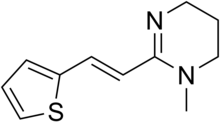 | |
| Clinical data | |
|---|---|
| Trade names | Pin-X, Combantrin, others[1] |
| Routes of administration | by mouth |
| ATC code | |
| Legal status | |
| Legal status |
|
| Pharmacokinetic data | |
| Bioavailability | poorly absorbed |
| Identifiers | |
| |
| CAS Number | |
| PubChem CID | |
| DrugBank | |
| ChemSpider | |
| UNII | |
| KEGG | |
| ChEBI | |
| ChEMBL | |
| CompTox Dashboard (EPA) | |
| ECHA InfoCard | 100.036.143 |
| Chemical and physical data | |
| Formula | C11H14N2S |
| Molar mass | 206.31 g·mol−1 |
| 3D model (JSmol) | |
| Melting point | 178 to 179 °C (352 to 354 °F) |
| |
| |
Pyrantel is a medication used to treat a number of parasitic worm infections.[2] This includes ascariasis, hookworm infections, enterobiasis (pinworm infection), trichostrongyliasis, and trichinellosis.[2] It is taken by mouth.[2]
Side effects include nausea, headache, dizziness, trouble sleeping, and rash.[2] A lower dose should be used in people with liver disease.[2] While it does not appear to be harmful during pregnancy, it has not been studied for this use.[3] It is unclear if it is safe for use during breastfeeding.[2] It is in the antihelmintic family of medications.[4] It works by paralyzing worms.[4]
Pyrantel was initially described in 1965.[5] It is on the World Health Organization's List of Essential Medicines.[6] Pyrantel is available as a generic medication.[4] It may also be used to treat worms in a number of other animals.[5]
- ^ Hamilton R (2015). Tarascon Pocket Pharmacopoeia 2015 Deluxe Lab-Coat Edition. Jones & Bartlett Learning. p. 54. ISBN 9781284057560.
- ^ a b c d e f World Health Organization (2009). Stuart MC, Kouimtzi M, Hill SR (eds.). WHO Model Formulary 2008. World Health Organization. pp. 89, 608. hdl:10665/44053. ISBN 9789241547659.
- ^ "Pyrantel Use During Pregnancy". Drugs.com. Archived from the original on 20 December 2016. Retrieved 8 December 2016.
- ^ a b c "Pyrantel Pamoate". The American Society of Health-System Pharmacists. Archived from the original on 20 December 2016. Retrieved 8 December 2016.
- ^ a b Maddison JE, Page SW, Church DB (2008). Small Animal Clinical Pharmacology. Elsevier Health Sciences. p. 209. ISBN 978-0702028588. Archived from the original on 2016-12-20.
- ^ World Health Organization (2019). World Health Organization model list of essential medicines: 21st list 2019. Geneva: World Health Organization. hdl:10665/325771. WHO/MVP/EMP/IAU/2019.06. License: CC BY-NC-SA 3.0 IGO.